The genre of Sci-fi has an extensive history given the number of classics it has churned out in the past. They have featured some ferocious creatures coupled with good scripts, stupendous special effects, and a good cast.
You must’ve guessed it by now that we are taking about the Tremors franchise. The franchise commenced in 1990 with a sci-fi horror-comedy of the same name Starring Kevin Bacon and Fred Ward this became a favorite among the audience special thanks to the gigantic Graboids, which were work like monsters.
This masterpiece was highly regarded among B-horror films and was a product of love for this genre. It displayed a combination of the atomic age of the 1950s and modern special effects. This no-brainer is far from something you can dismiss given its well-crafted script and solid performances.
Academy Award winners Alec Gillis and Tom Woodruff Jr., forming Amalgamated Dynamics, were responsible for the stunning creature effects. The titular beast is known as one of the most ferocious beast in B-movies and this video will be your guide.
The Tremors Franchise so Far and a Quick Review
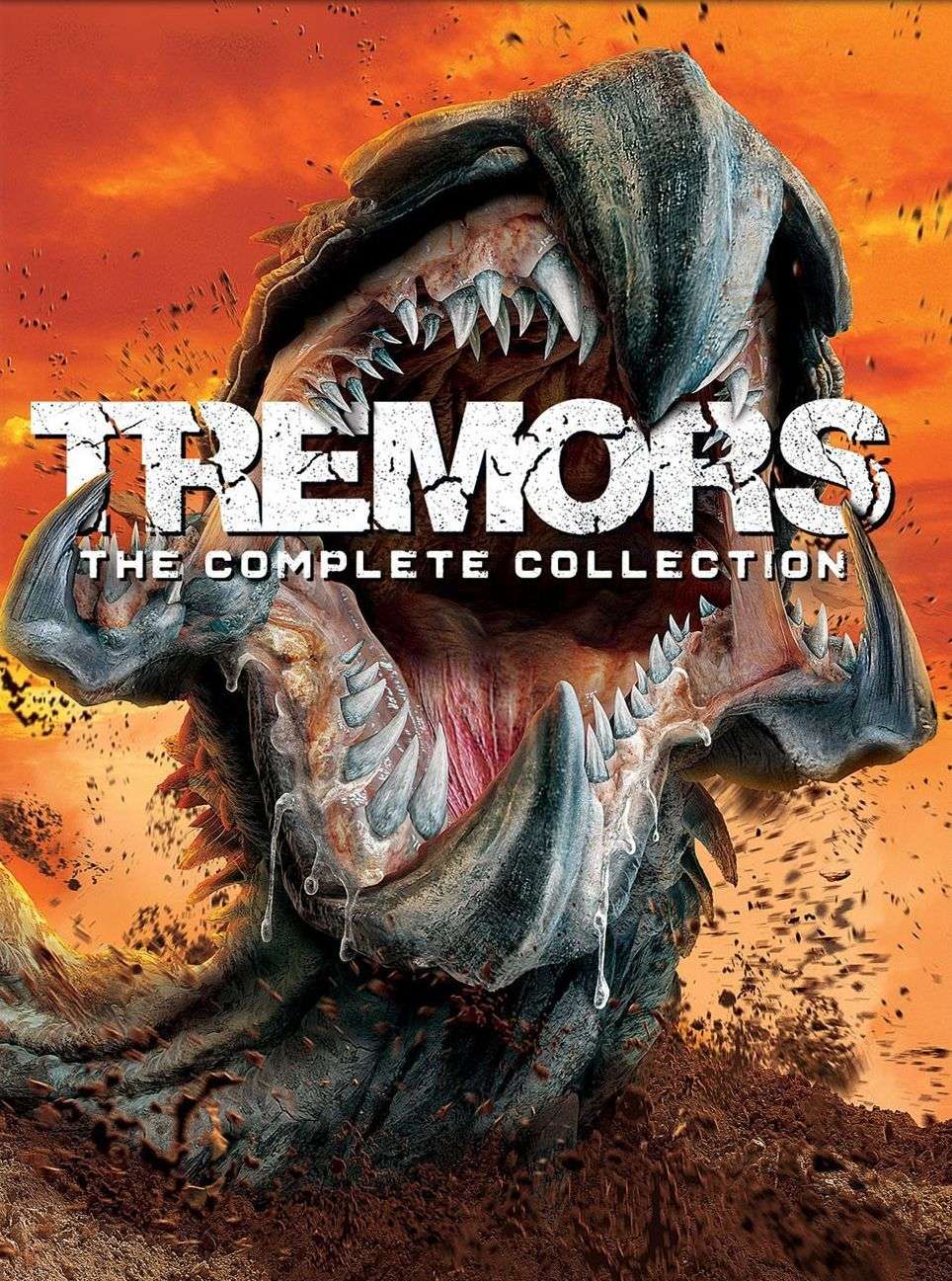
Before we dive further into the Graboids, let us give you a quick recap of this popular franchise. There have been five sequels and one prequel post the release of the first movie. The Tremors sequels have all been direct-to-video boating of consistent quality. None of them have stooped to the cynical self-parody nature that most of the films in the same genre display or the humorous tone that B-movies tend to generally retain.
This series has specifically avoided complications regarding the Graboids despite being the main characters. The plot is fairly simple- a conundrum of wacky characters in complicated situations where they must bear the wrath of the monsters.
While the films have witnessed a shrinking budget in the past years, they have been able to salvage the special effects with whatever little they had. The Graboids were completely CGI in the two recent installments, but the quality of the digital effects has been quite advanced compared to the lackluster show in Tremors 3.
The intense action is definitely a highlight of the series. The monstrous worm-like entity has traveled an entire life cycle in the course of the series. We saw them from larva to worm to the bipedal Shrieker and Ass-Blaster.
Over the years, the Graboids and the Ass-Blasters have been redesigned to some extent, but they never lost their charm courtesy of such practical effects as toppled buildings, destroyed cars, and worm guts exploding. As the franchise progressed, the humor seemed to have become crass but that was in keeping with the changing taste of the cable audiences as well!
So what keeps the charm alive without making the narrative monotonous? The constant tussle between the humans and Graboids is rather interesting to observe given how each time the humans find new strategies against the Graboids, they adapt to the changes just fast, putting us back in square one. This makes it a serious cat-and-mouse game that is engaging for the viewer.
There is one thing, however, that has remained constant over the years- the presence of Burt in all six movies. Given Michael Gross’ fine performance as the crazy guy we were more than happy to see him as a constant fixture. Gigantic man-eating monsters, fun characters, and intense drama has given Tremors the popularity it enjoys today.
What Are Graboids And What Is Their Origin?
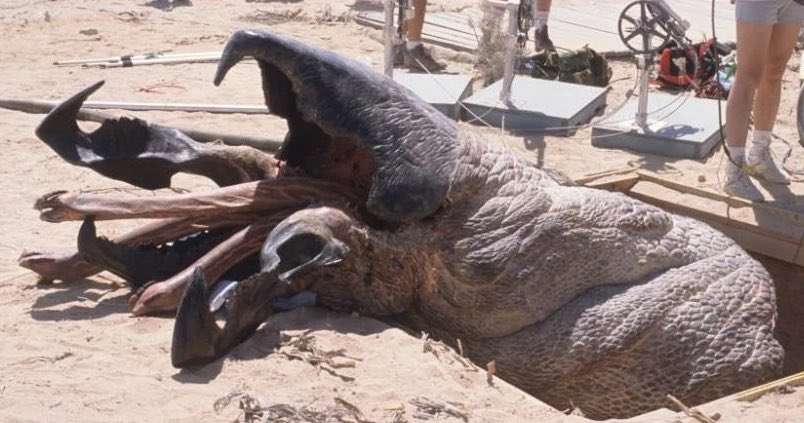
Graboid, a.k.a the Dirt Monster is the mean subterranean monster that features as the prime antagonist of the films. This invertebrate species has been present in each of the movies. The creature designs were handled by Brent Maddock, S.S. Wilson, and Ron Underwood, and they did a fabulous job with this intimidating worm.
From our previous knowledge, we know that Graboids have originated prior to the events of the film. In Tremors 5: Bloodlines, cave paintings of Graboids indicate their existence alongside the ancient cavemen, however the makers were not too concerned to show us the true origin of the Graboids.
In Tremors 2, evidence suggests that the Graboid spike dates back to the Precambrian era and points to an Earthly origin. They can be assumed to have co-existed with dinosaurs and managed to avoid extinction owing to extreme adaptability. Graboids are gigantic, carnivorous worms that have changed noticeably after the extinction of dinosaurs.
We know that the Sierra Nevada region has continued to rise until recently, and that restricted the geographic location of some of the large predators. Maybe, the same happened with the Graboids who got stuck in the Wild West! Their food sources were limited and only those that adapted to the changing conditions managed to survive.
The mountains on all sides have probably restricted their movement because, although these monsters travel through dirt, they need a specific type of earth to move through. As we have observed in the movies, clay or other such compact forms of dirt make their movement difficult. We have seen a Graboid perish while trying to break through concrete!
We are introduced to the American species in the first movie but we must not forget the African species that differs physiologically. Their biological constitution offers invaluable insights on their behavior and movements.
Including the American and African variants, the Garboids have four types of variants. We were introduced to the Arctic ones in Tremors: A Cold Day in Hell. These Graboids can move through thin sheets of ice underneath the surface. In Tremors: Shrieker Island, we witnessed other variants cross the ocean and defy the initial beliefs of the scientists studying them.
Standard Graboids (American variant)
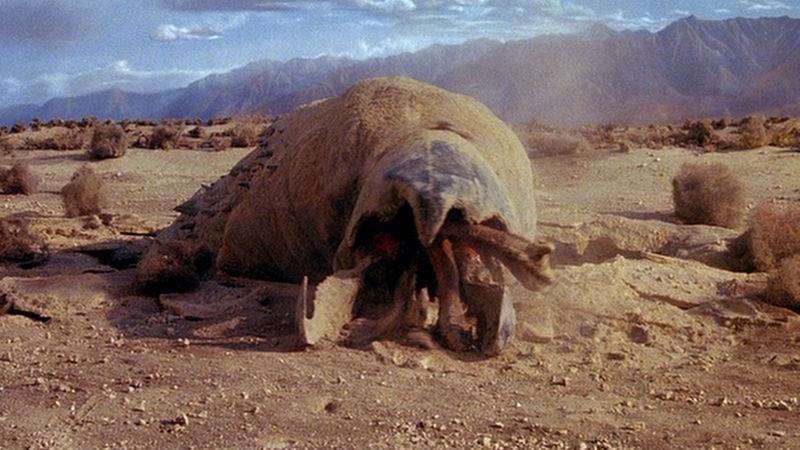
The Standard Garboids look like gigantic worms with a long, serpentine body that can be as long as 30 feet in length and 6 feet in width. From what we saw in Tremors 4, it takes a Graboid about three months to reach this size, and the thick-skinned creature is capable of withstanding bullets or other attacks.
They probably have a semi-rigid structure, if not a proper skeleton, because the thick muscular tissue is surely wrapped around something! Otherwise, it wouldn’t have the necessary strength to move through the dirt and small rocks under the surface, and break through hard surfaces to nab its prey. Besides, the Graboid can lift up its upper body in the air, and that wouldn’t be possible without some kind of semi-rigid internal structure.
It is important to note that the shape of its jaws and upper torso help it propel through the ground and move at a decent speed as well. The internal structure coupled with the muscles would help it to flex its entire body and move in a corkscrew motion underground. They lack either eyes or nose while their head resembles an armored beak.
Their beak opens into a horrifying flower-like structure where the upper and thin lower jaw is visible. They have hooked mandibles on either side which serve pretty useful for navigation. Their most lethal weapon could be the three serpent-like tentacles they have with a reach of ten feet.
Retracted in the Graboid’s throat, these were initially mistaken as the real creature which is probably why the characters of the first movie remained unaware of the volume of looming threat.
These tentacles have a mouth, teeth, and two pairs of horn-like projections of its own on the jaws. They not only help in grabbing the prey but also help in sensing vibrations on the ground. The sight of these tentacles or tongues, hissing and writhing, is unforgettable for those who have watched the movies!
The name Graboids couldn’t have been any better because that is precisely what they do! Grab their prey and suck it down their throat. The Graboids can quickly tell if the thing they consumed is edible and the tentacles probably have a sensation of taste. If they find it inappropriate, they quickly spit it out.
Their eating styles vary in each movie, slowing them whole or dismembering them as per the demands of the movie. They have a slow metabolism but are definitely strong considering they are capable of without chewing their prey! Other Graboids eat metals.
The question arises whether they retain minerals from consuming the metal-there is no mention of the same. However their enhanced running post consumption makes as want to believe that maybe they do.
Their thick, leathery hide offers them protection against regular bullets, and one would need something as strong as dynamite explosions or large-bore rounds to do some damage. Shooting them in their jaws helps because they seem to be vulnerable when their tentacles are attacked. In the first movie, we saw guns intended for shooting elephants doing some damage!
Graboids are extremely strong capable of toppling over vehicles and even houses for that matter. They can move through tough surfaces with help of the short spikes on their backs, making them capable of even breaking through brick walls and other solid structure. Their speed varies depending on the quality of the surface where they can reach velocities of 15-20 mph on loose soil but on tough soil they are slower.
The Graboids cannot outrun motorized vehicles, and even galloping horses have proven to be too fast for them. The distinctive orange blood is pretty unique, and although the first few movies did not highlight the stench, we saw that being a crucial aspect in Tremors 4.
Graboids have a few weaknesses that can be used against them. For instance, they cannot tell the environment they are traveling through, and often, it is too late for recovery by the time they realize! This explains how one of them was tricked into running off a cliff and falling to its death.
A question arises if Graboid breathe under the soil. From the looks of it, they have the same nitrogen-oxygen atmosphere as other animals, and from the way it has been heard expelling air, the creature probably has lungs as well. The Graboids have one more secret ability that helps them survive without prey for long.
They can spend years in dormancy, given they do not enjoy an abundant supply of food in the wilderness, where their metabolism is slowed and they can go on without food. Once they eat, they need time to rest and digest. We have seen a fully fed Ass Blaster collapsing into a food coma to digest and regain its strength.
African Species
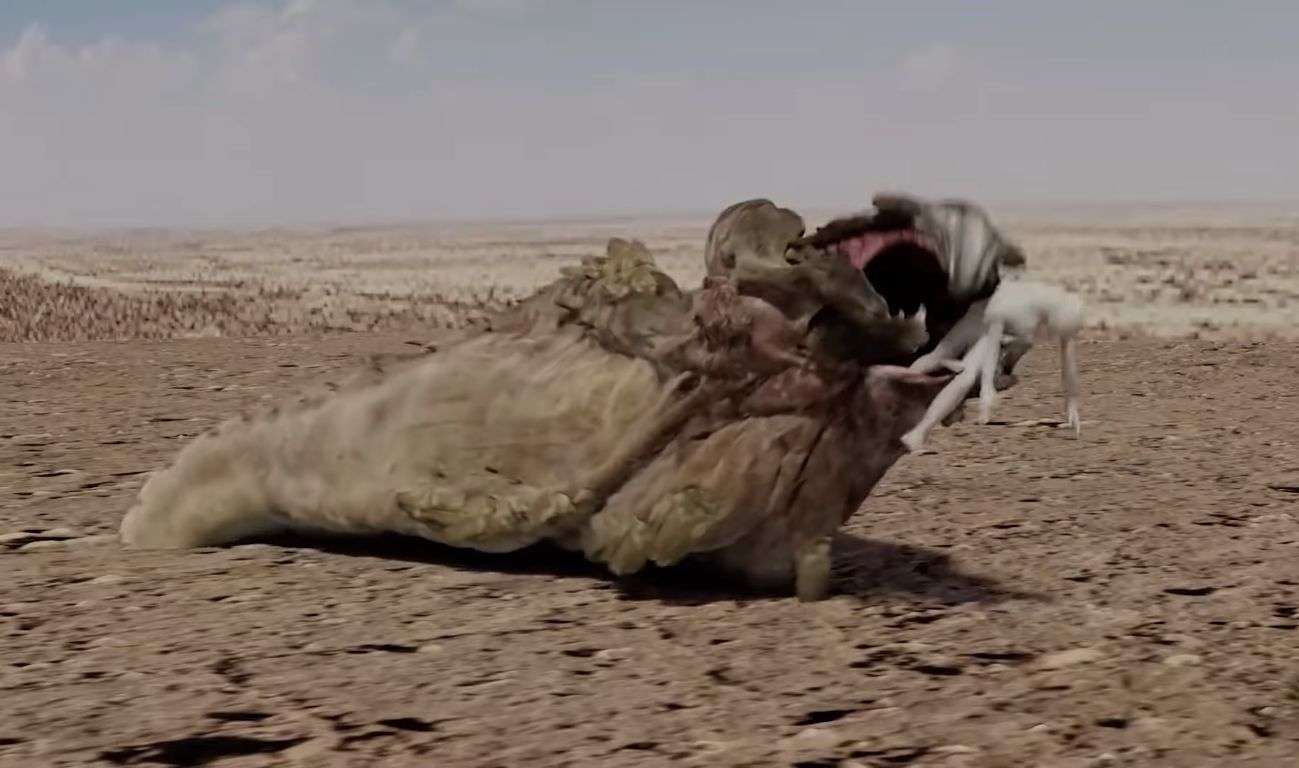
The African Graboids are found in the Southern Hemisphere and Africa in general. While they share a similar life cycle as their American contemporaries we are not sure of how branched out they are from them. Their ability to swim, seen in the recent movies, certainly come in handy.
According to Burt, the constant character in the series, the African version is longer, slimmer, and probably better adapted to their surroundings. Instead of the semi-rigid structure of the American Graboids, the African ones have a well-developed structure with skeletons that can fossilize.
We haven’t seen the Shrieker stage in the African variant, and this indicates that they could bypass this stage entirely. A unique feature they display is how their tentacles can detach from the host and pursue a prey on their own. Once separated from the main body, they become faster and can even climb rocky surfaces.
At the same time, they are more vulnerable in this stage, and we have seen in Tremors 5: Bloodlines that their hunting pattern is a lot more aggressive. They were shown to be far more agile than the American Graboids, and could launch themselves out of the dirt to hunt their prey. Maybe the agility was a necessity to catch their targets which included the fast animals of Africa.
Another crucial feature that made the African species deadlier is the fact that they could dig through rocks by releasing formic acid to soften them. They would then use their mandibles to eat through it, and rocks wouldn’t be a restricting factor for these monsters anymore! In the first movie, we have seen the survivors trying to get on top of rocky surfaces to get away from the Graboids, but clearly it wouldn’t work in the case of the African ones.
There is also a clear difference of priority between the American and African Graboids. The African ones are keener to further their bloodline, while the American variant is all about hunting their prey. We have seen them cooperating with the Ass Blasters to protect their nests at all costs.
There is a Graboid called The Queen Bitch that was like the leader of the nest and worked to protect the African bloodline. Usually, the Ass Blasters and Graboids ignore each other, and there have even been instances where a Graboid ate an Ass Blaster, but things changed when it came to the protection of their nest.
Arctic Species
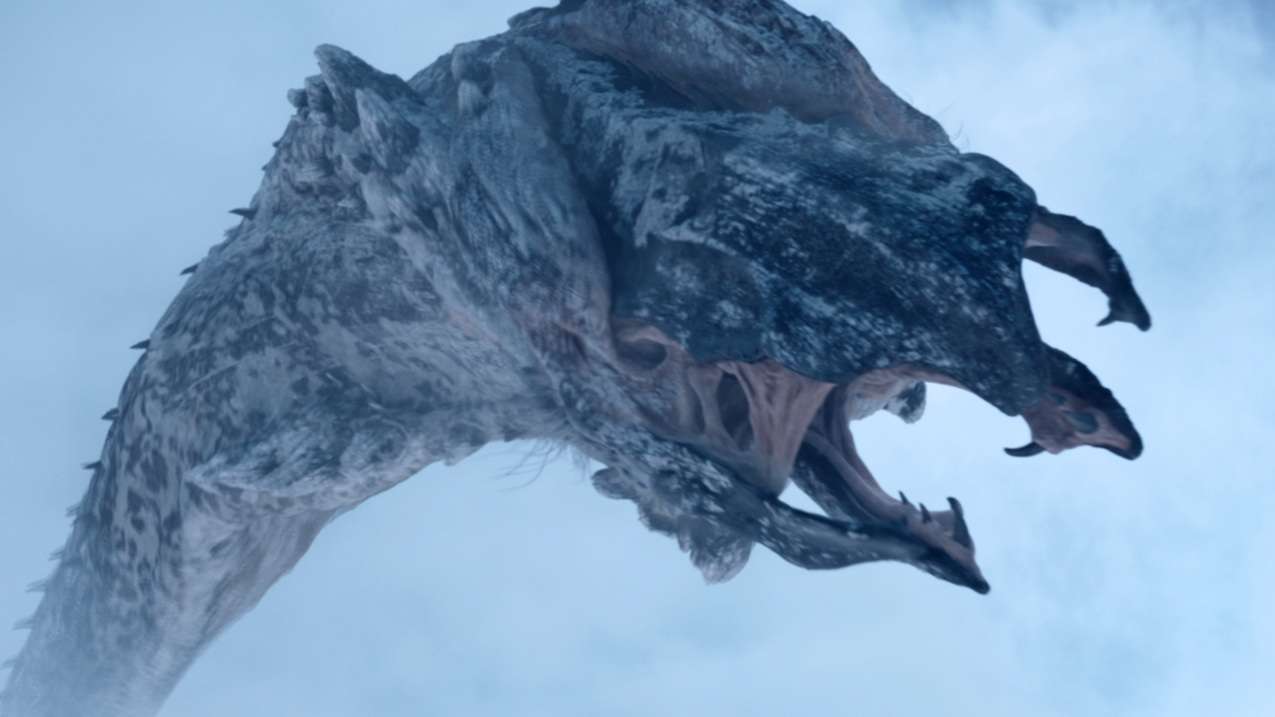
This species of Graboids are located in the Arctic regions. They share similar features with their Asian and African counterparts. Just like their African counterparts, they have no Shrieker stage. The common traits in the variants hint that they may have had common ancestors or are related to the common ancestors of other Graboids.
They can endure harsh, cold conditions, but there is a chance that the Arctic Graboids did not start off by living under icy conditions. They probably got trapped and later adapted to the frost.
We don’t know if they had a skeletal structure like their African relatives did, but according to Burt, they could have been modified to serve as some kind of bio-weapons. Given how old these creatures probably existed, it is unlikely that there are many facts to support such speculation.
Oceanic Species
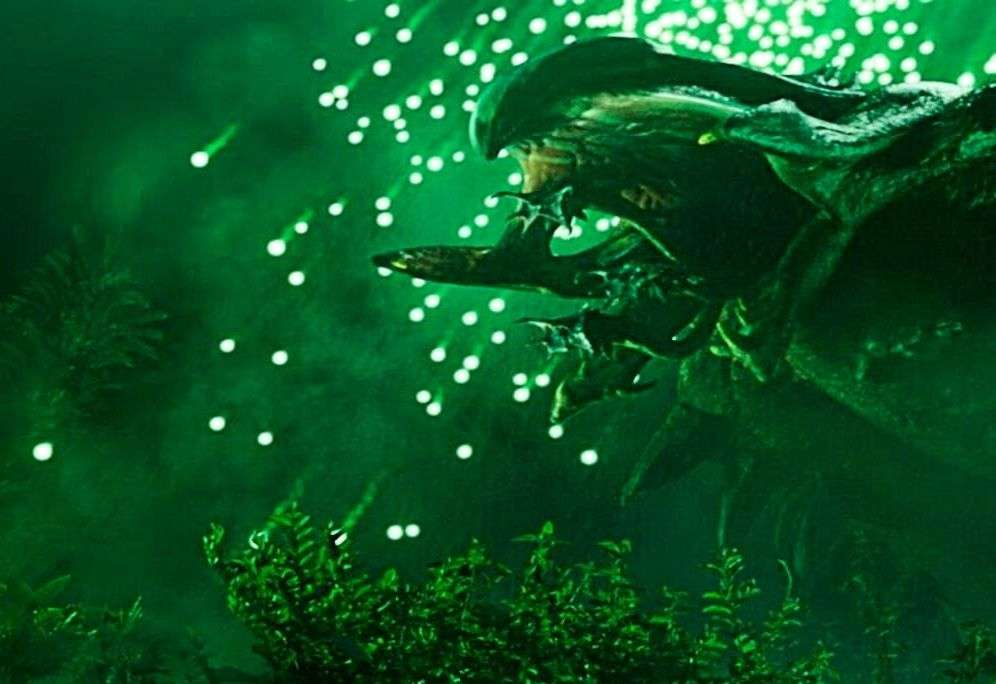
Tremors: Shrieker Island showed Graboids that could easily cross oceans. The recent addition to the franchise tried to imply that this quality was a part of their evolution, but this ability might indicate the presence of these creatures in different continents! Maybe, it is an ancient capability that the American Graboids lack because their surroundings do not demand it.
The Queen Graboid burrows from one island to the next, but there is a lot of confusion surrounding the emergence of this ability. Bill was breeding Graboids in the islands, and it is possible that somehow that led to a new species with a special quality. However, evolution is a more plausible option than the breeding theory!
We have witnessed in the previous movies that water has no negative bearing on Graboids. In fact the Arctic Graboids can easily sail through ice and water quite flawlessly. We do not know about the creature’s diving skills. However they managed to do so, it is certainly a unique quality that will be exciting to watch in future additions to the franchise.
Life Cycle And Different Types Of Graboids – Explained
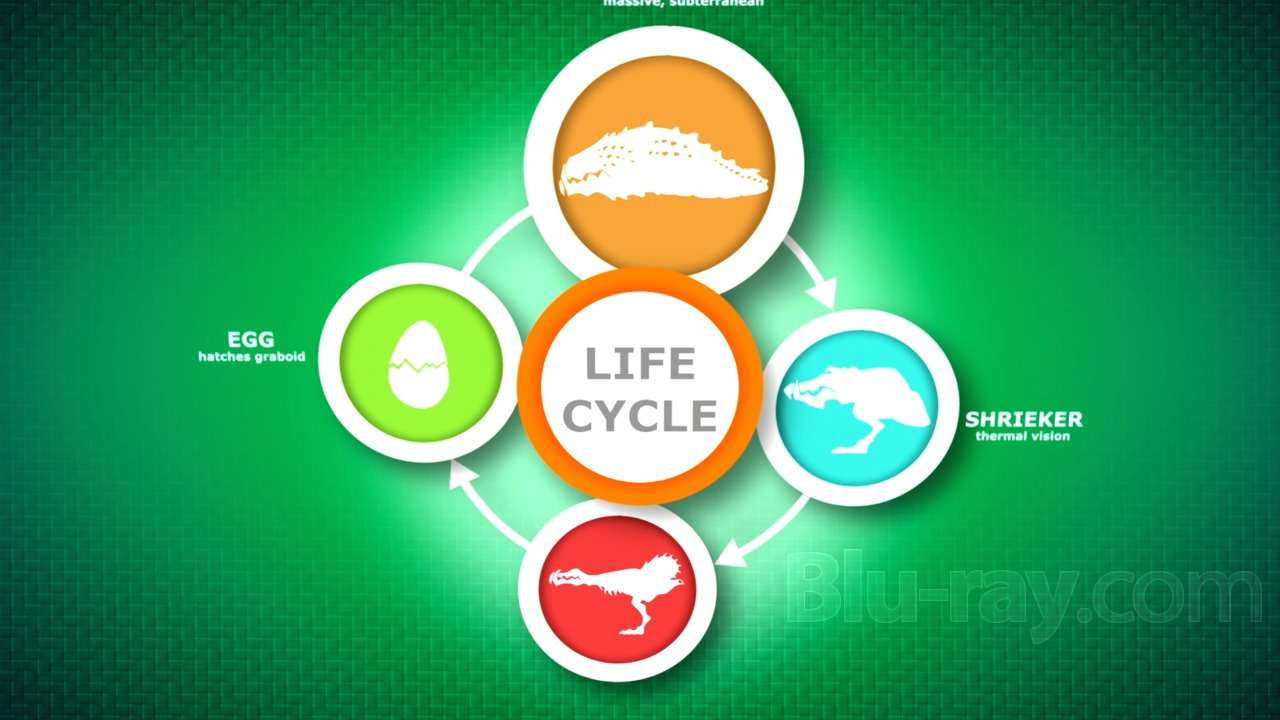
You have probably heard a bit too much about Graboids without learning how their life cycle functions. For that, we must take you through their reproductive cycle and the changes from a Graboid to a Shrieker to Ass Blasters to eggs that hatch into Graboids. It is more of a vicious rebirth and we can begin with just about anything!
The Graboid eggs are laid by Ass Blasters which hatch into Dirt Dragons and are the baby Graboids we see in Tremors 4. They grow into the standard Graboid that we have largely seen throughout the series, and this is actually the first stage of their life cycle.
It can die if it consumes a lot of food. The tentacles or the tongues, however, live on, and they transform into Shriekers. The birth of a Shrieker is characterized by the sides of the Graboid being blown out, and it leaves a gaping hole in the long worm-like body.
Shriekers
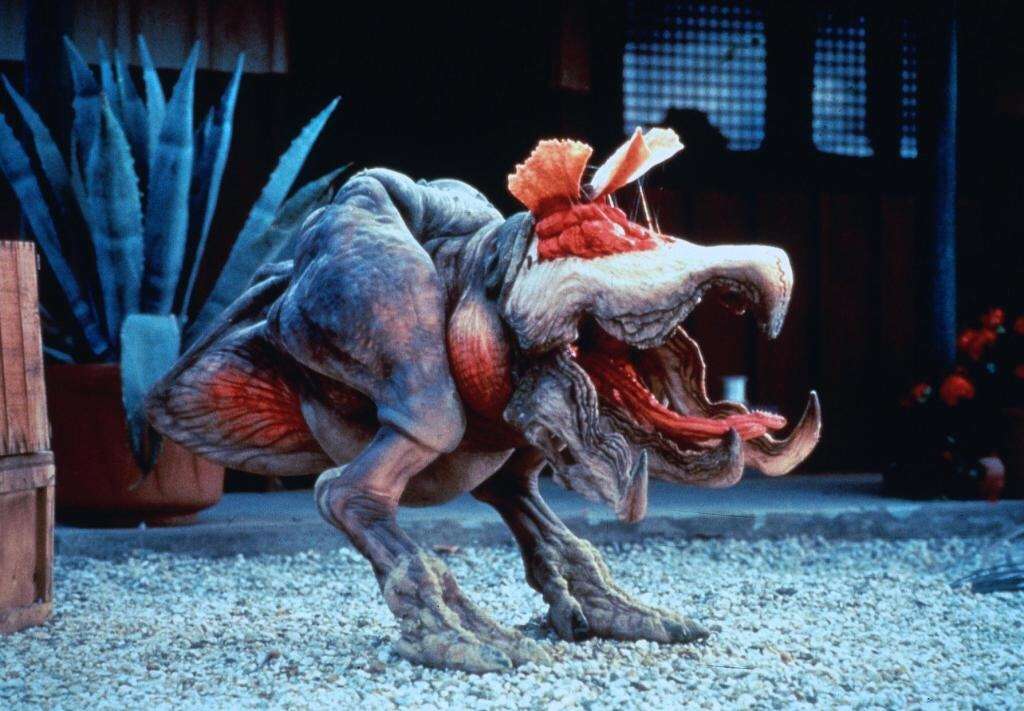
Shriekers are asexual creatures with one goal- produce replicas of themselves. They need to consume sufficient food to be able to do so and then open their mouth as widely as possible to drop a fetus on the ground. This causes them to screech loudly, hence drawing the name! They keep growing exponentially and the repeated stress eventually leads to their death!
The Shriekers are known to live on the surface, unlike the Graboids, and are way smaller than their subterranean counterparts. They are about four feet long and three feet tall, and look like miniature dinosaurs!
Unlike the Graboids, who are solitary hunters, the Shriekers hunt in packs, and this helps them to bring down large prey. They are one of the most dangerous forms due to being able to run on land, travel underground, and reproduce fast!
Assblaster
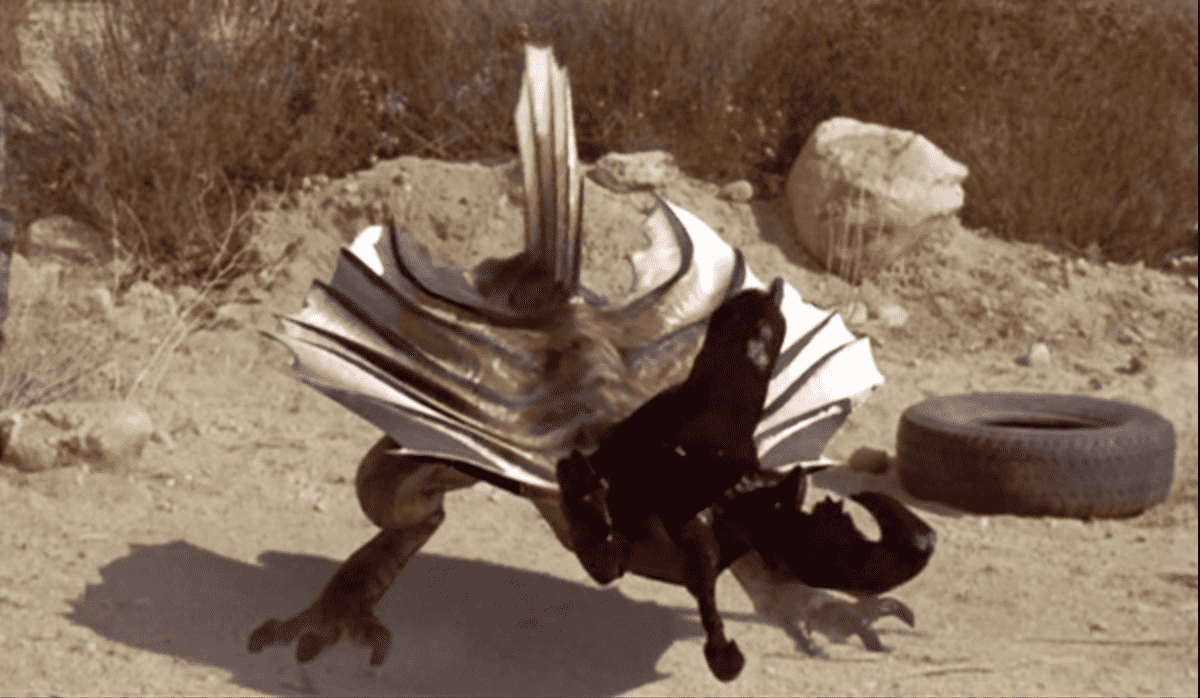
This is the next and final stage in the life cycle, and is possibly the most bizarre! When the Shrieker gives birth, it is like a flying Shrieker that gained the power of flight by way of shaking its tail and backside! It seems to mix the liquids that cause a mini-explosion through their rear, and it can soar through the air.
Assblasters are capable of running on foot and have great speed to catch up with their prey. They have a sort of sail-like structure on the sides of their bodies and this helps them glide smoothly. They even have a hint of a tail in their weird structure. The African Ass Blaster is stronger than their North American variant as they are capable of ripping apart vehicles. Eventually, they eat a large quantity of food and lay a Graboid Egg before dying.
In Tremors 5, we saw around six Ass Blasters laying around a dozen eggs which implies that they can conceive more than one egg. The cycle of terror goes on in a relentless circle!
The Graboids can be opportunistic cannibals and they can prey on the Assblaster as we saw in Tremors 3. However, the protection of the nest is the top priority and during such times, they form a symbiotic relationship for mutual benefits.
How Smart Are The Creatures?
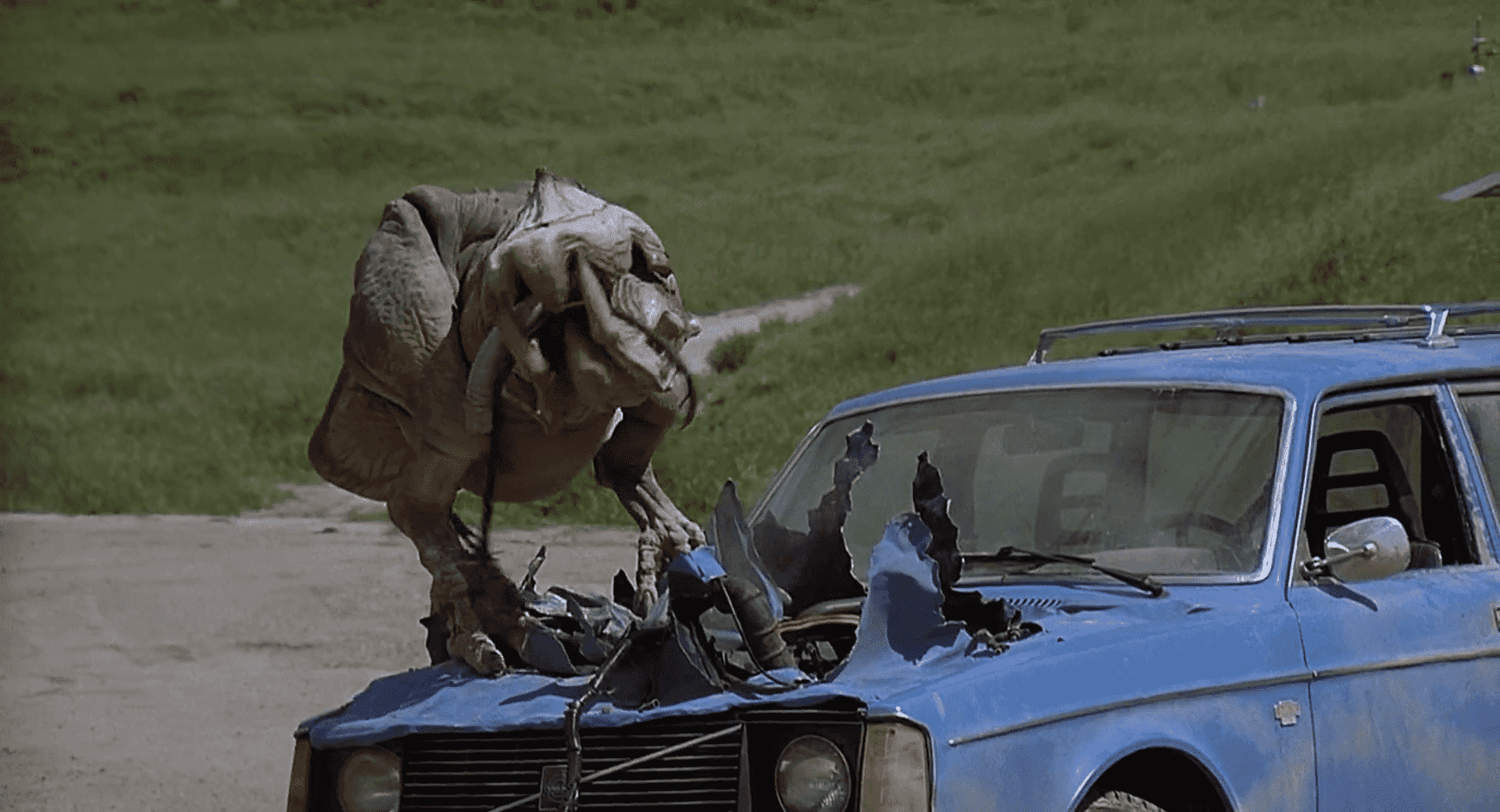
You often come across monster flicks where the creature is dumb as a doorknob. While they might still be terrifying, outsmarting them becomes easier. The Graboids are ravenous carnivores with a knack for hunting, and they have developed quite a brain for that. They prey on everything from cattle, horses, sheep, and even humans, and for that, they have developed various stratagems.
These creatures are devoid of the senses of smell or sight because they do not have an eye or a nose! So, their hunting tactic is restricted to picking off prey by tracking their seismic vibrations that are caused due to movement. The worms, however, cannot differentiate between the inedible and edible vibrations.
As a result, they consume the thing first without inspecting and regurgitate stuff that does not taste good. These monsters are extremely sensitive to any kind of sound, and thus, a loud bang from an intensity blast causes them a lot of pain. It becomes a sensory overload, and this is also the reason why they are unable to hunt during a thunderstorm.
Their predatory techniques include sudden strikes. These are ambush predators that can sneak up on their target and take them by surprise. However, we have seen plenty of instances where they chased their victims with great determination over a considerable distance.
The prey could seek refuge on higher grounds, but the creature simply digs away the Earth till the victim collapses. We have seen instances of their immense patience which is one of their strongest hunting traits.
When they are unable to locate a prey exactly, they circle around the suspected location. They can wait long enough for the victim to die of dehydration. If you have watched the first Tremor movie, you surely remember the moment when a man died of dehydration on top of an electric tower!
We don’t know much about their nervous system, but they seem to have a sophisticated brain that allows them to strategize in such detail. They have shown signs of intelligence, and more importantly, the Graboids can learn from their past memories. In the first Tremor movie, the survivors managed to kill a Graboid using dynamite.
They drew it out by using the vibrations caused by the dynamite and timed it such that it exploded once it was swallowed. But, when they tried doing it again, the second Graboid seemed to have learned from the trap. It simply regurgitated the dynamite before it could do any damage.
There are many other examples that point to the intellect of these entities. When the people tried to get away on a bulldozer and it was too big to be toppled over, the Graboids simply dug up a trap in its path. Besides their hunting prowess, these creatures could also communicate with each other using a wide variety of noises that alerted others regarding a particular food source.
The only way to survive an attack is to remain completely motionless. These monsters thrive on the vibrations created by our movements and remaining still misleads them. However, it is important to choose the place correctly because you don’t want to die of dehydration like the old man in the first movie!
Future of The Franchise – When is Tremors 8 going to release?
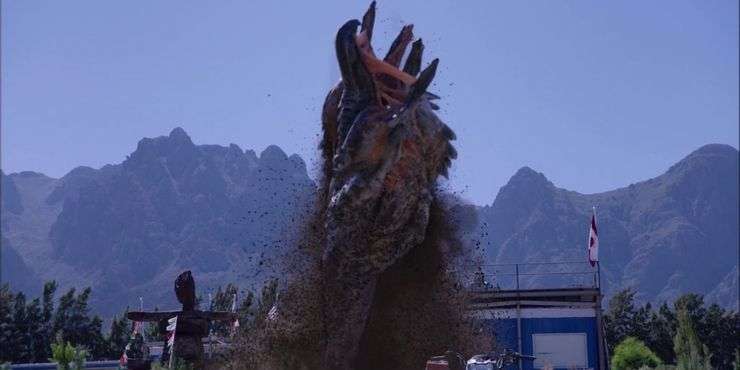
Tremors has developed a cult following over the years, and it is no surprise that fans are awaiting further sequels. The last addition to this cult horror-comedy series was Tremors: Shrieker Island, and Michael Gross returned as the iconic Burt Gummer, the constant survivalist in the franchise.
It released on the 20th of October, 2020, and ended on a conclusive note. This time Burt had to tackle genetically-manipulated Graboids called Shriekers, and speculations are rife regarding the possibility of adding to the storyline.
However, there is some bad news for the loyal fans as Shrieker Island ended with the shocking death of Burt Gummer. His self-sacrificial act saw him devoured by a gigantic Graboid. He has been a part of the Tremors legacy for thirty long years, and his death marks the end of an era. So, will there be a Tremors 8? There are both sides of the coin to consider here.
For one, Universal Home Entertainment might feel that they have had enough with Tremors, and with their constant character gone, it might just signify the end. However, Michael Gross has stated that there is room for an eighth Tremors movie.
Currently there is nothing to substantiate the claims of another movie in the series or for that matter a reboot. Gross has reportedly said in an interview that he would consider for being on board for a reboot only if the original cast of Fred Ward and Kevin Bacon become a part of the project.
If the production of Tremors 8 was to be taken seriously, the plot would’ve picked up from events of Shrieker Island. Given the excellent premise, there is a possibility of exploring Burt’s death and what had actually happened. Gross has given his word to ensure his fitness for any sequel till 2022 that gives us more than a year to wait in anticipation.
While we wait with bated breath for Tremors 8, we hope that it will be able to carry forward the legacy the previous films have left us with. We would rather have no movies in the series than one that leaves a bad aftertaste!
